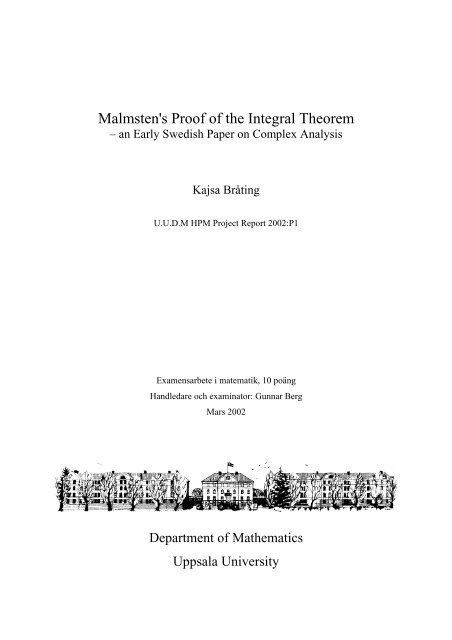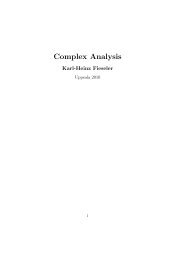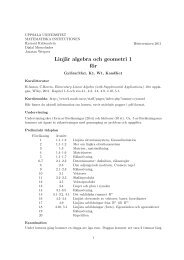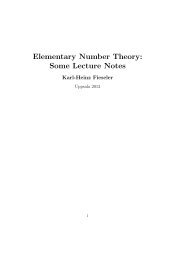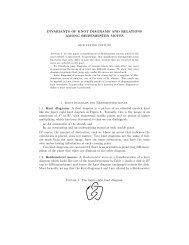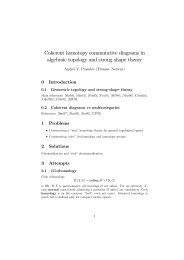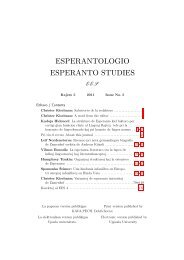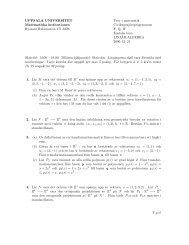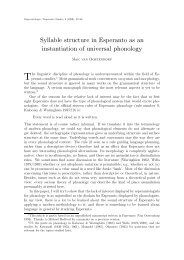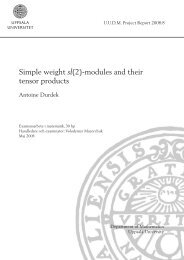Malmsten's Proof of the Integral Theorem
Malmsten's Proof of the Integral Theorem
Malmsten's Proof of the Integral Theorem
- No tags were found...
You also want an ePaper? Increase the reach of your titles
YUMPU automatically turns print PDFs into web optimized ePapers that Google loves.
<strong>Malmsten's</strong> <strong>Pro<strong>of</strong></strong> <strong>of</strong> <strong>the</strong> <strong>Integral</strong> <strong>Theorem</strong>– an Early Swedish Paper on Complex AnalysisKajsa BråtingU.U.D.M HPM Project Report 2002:P1Examensarbete i matematik, 10 poängHandledare och examinator: Gunnar BergMars 2002Department <strong>of</strong> Ma<strong>the</strong>maticsUppsala University
Malmsten’s <strong>Pro<strong>of</strong></strong> <strong>of</strong> The <strong>Integral</strong> <strong>Theorem</strong>-an Early Swedish Paper on Complex AnalysisKajsa Bråting21st February 2002
AbstractIn this report we consider <strong>the</strong> Swedish ma<strong>the</strong>matician C. J. Malmsten’sarticle “Om definita integraler mellan imaginära gränsor” from1865. In his article, Malmsten gives a pro<strong>of</strong> <strong>of</strong> <strong>the</strong> Cauchy integral <strong>the</strong>oremwhere <strong>the</strong> limits <strong>of</strong> integration are complex numbers. The aims<strong>of</strong> this report is to try to catch <strong>the</strong> techniques that Malmsten made use<strong>of</strong> in his pro<strong>of</strong> and to get a glimpse <strong>of</strong> <strong>the</strong> ma<strong>the</strong>matical concepts atthis time, especially those which weren’t fully investigated and <strong>the</strong>rebygave rise to some problems for <strong>the</strong> ma<strong>the</strong>maticians.1
Contents1 Introduction 32 Biography <strong>of</strong> Malmsten 33 A short History <strong>of</strong> Complex Analysis 53.1 Development <strong>of</strong> <strong>the</strong> Eighteenth Century . . . . . . . . . . . . 53.2 The Geometric Representation <strong>of</strong> a Complex Number . . . . 63.3 Complex Integration . . . . . . . . . . . . . . . . . . . . . . . 74 Cauchy and <strong>the</strong> <strong>Integral</strong> <strong>Theorem</strong> 84.1 Biography <strong>of</strong> Cauchy . . . . . . . . . . . . . . . . . . . . . . . 84.2 The Cauchy <strong>Integral</strong> <strong>Theorem</strong> . . . . . . . . . . . . . . . . . . 95 Malmsten´s Article: “Om definita integraler mellan imaginäragränsor” 125.1 The Insufficiencies in Cauchy’s <strong>Pro<strong>of</strong></strong> According to Malmsten 135.2 How Malmsten Proves <strong>the</strong> Existence <strong>of</strong> <strong>the</strong> <strong>Integral</strong>s . . . . . 145.3 The Various Properties <strong>of</strong> <strong>the</strong> <strong>Integral</strong> . . . . . . . . . . . . . 196 Final Remarks 202
1 IntroductionDuring <strong>the</strong> eighteenth century <strong>the</strong> ma<strong>the</strong>maticians in Uppsala were mainlyastronomers, physicists or <strong>the</strong>ologians. In fact, it wasn’t until <strong>the</strong> 1820sthat Uppsala, as well as Lund, got <strong>the</strong>ir first pure ma<strong>the</strong>maticians. Maybethis was a natural ongoing process toward specialization. It could also havebeen due to <strong>the</strong> fact that <strong>the</strong> rumors <strong>of</strong> great works <strong>of</strong> Euler, d’Alembert,Lagrange and Laplace now had reached <strong>the</strong> universities <strong>of</strong> Scandinavia [3]. InUppsala, at <strong>the</strong> time, a new generation <strong>of</strong> talented ma<strong>the</strong>maticians appeared.Among <strong>the</strong> most prominent were Adolf Fredrik Svanberg (1806-1857), CarlJohan Malmsten (1814-1886) and Emanuel Gabriel Björling (1808-1872).In this report we discuss <strong>the</strong> article “Om definita integraler mellan imaginäragränsor”, which was written by C. J. Malmsten in 1865. In his work,Malmsten gives a pro<strong>of</strong> <strong>of</strong> Cauchy’s integral <strong>the</strong>orem, i.e. that <strong>the</strong> integralis independent <strong>of</strong> <strong>the</strong> path <strong>of</strong> integration (where <strong>the</strong> limits <strong>of</strong> integrationare complex numbers). The aims <strong>of</strong> this report is to try to catch <strong>the</strong> techniquesthat Malmsten made use <strong>of</strong> in his pro<strong>of</strong> and to get a glimpse <strong>of</strong> <strong>the</strong>ma<strong>the</strong>matical concepts at this time, especially those which weren’t fully investigatedand <strong>the</strong>reby gave rise to some problems for <strong>the</strong> ma<strong>the</strong>maticians.The intention is also, to some extent, to become acquainted with <strong>the</strong> ma<strong>the</strong>maticalarena in Sweden at this time.To give a background to Malmsten’s article and to see how far <strong>the</strong> development<strong>of</strong> complex analysis had reached at this time, we begin with ashort history <strong>of</strong> this field. Subsequently, a summary <strong>of</strong> Cauchy’s pro<strong>of</strong> <strong>of</strong><strong>the</strong> integral <strong>the</strong>orem will be presented, followed by a biography <strong>of</strong> Cauchy,before <strong>the</strong> exposition <strong>of</strong> Malmsten’s article. However, <strong>the</strong> report begins witha biography <strong>of</strong> Malmsten.2 Biography <strong>of</strong> MalmstenCarl Johan Malmsten (1814-1886) grew up in Uddetorp, not far from Skara.Shortly after <strong>the</strong> death <strong>of</strong> his fa<strong>the</strong>r (1827) Malmsten, who at <strong>the</strong> time wasin ’Skara skola’, obtained a favourable position as a tutor. This post made itpossible for Malmsten to study without interruptions and he was able to keep<strong>the</strong> post during his upper secondary studies as well as his university studies.In 1833 Malmsten began to study ma<strong>the</strong>matics at Uppsala university wherehe 1839 received a doctoral degree.In competition with E. G. Björling (1808-1872) Malmsten became pr<strong>of</strong>essor<strong>of</strong> ma<strong>the</strong>matics in 1841 and <strong>the</strong>reby succeeded his own teacher Jöns3
Svanberg (1771-1851) [3]. In <strong>the</strong> same year Malmsten was one <strong>of</strong> <strong>the</strong> initiators<strong>of</strong> Frey, a journal <strong>of</strong> art and science, which was published in ten volumes[9].During <strong>the</strong> 1840s Malmsten wrote many remarkable articles and becameafter Samuel Klingenstierna (1698-1765) <strong>the</strong> first Swedish ma<strong>the</strong>maticianwho not only followed <strong>the</strong> development <strong>of</strong> ma<strong>the</strong>matics <strong>of</strong> his time, butalso contributed to it [3]. He had a gift for languages and his lectures wereappreciated also by pure humanists. He was a friend <strong>of</strong> Geijer and took partin <strong>the</strong> social life <strong>of</strong> ’Malla Silfverstolpes salong’. One can say that Malmstencontributed to <strong>the</strong> fact that ma<strong>the</strong>matics became a ra<strong>the</strong>r popular topicduring <strong>the</strong> 1840s [9].In his own ma<strong>the</strong>matical research, Malmsten took an active part in analysis,algebra and probability <strong>the</strong>ory. In a summary <strong>of</strong> Malmsten’s ma<strong>the</strong>maticalresearch, Gösta Mittag Leffler (1846-1927) emphasizes his calculation<strong>of</strong> <strong>the</strong> remainder term in Euler’s “summation” formula as well as hissolutions <strong>of</strong> certain differential equations [9].Malmsten had a genuine interest in probability <strong>the</strong>ory, which mainlyresulted in his essays and popular lectures about <strong>the</strong> insurance business. Itis said that one <strong>of</strong> <strong>the</strong> motives was his sympathy for <strong>the</strong> misfortunate [9]. In1855 Malmsten was one <strong>of</strong> <strong>the</strong> founders <strong>of</strong> <strong>the</strong> insurance company ’Skandia’,where he was a director for many years.In 1858 Malmsten became a member <strong>of</strong> a committee, whose task was toinvestigate <strong>the</strong> pensions system. In 1859 he was appointed minister withoutportfolio and in 1866 county governor <strong>of</strong> ’Skaraborgs län’. In <strong>the</strong> course <strong>of</strong>time Malmsten did regret that he had given up science for politics. One <strong>of</strong><strong>the</strong> reasons that he didn’t return to his pr<strong>of</strong>essorship was consideration forhis substitute Daug, whose financial position was poor [9].In public life Malmsten became famous for a brilliant speech concerning<strong>the</strong> freedom for <strong>the</strong> press at <strong>the</strong> fiftieth anniversary <strong>of</strong> <strong>the</strong> constitution andfor his excellent dinners at <strong>the</strong> county governor’s house in Mariestad [3].The article “Om definita integraler mellan imaginära gränsor” was writtenafter Malmsten’s years as pr<strong>of</strong>essor (1865). A few years later <strong>the</strong> Cauchyintegral <strong>the</strong>orem, as well as <strong>the</strong> whole <strong>the</strong>ory <strong>of</strong> analytic functions, wouldprovide a lot <strong>of</strong> problems for <strong>the</strong> ma<strong>the</strong>maticians in Uppsala. It also gaverise to <strong>the</strong>ir own interpretations <strong>of</strong> <strong>the</strong> <strong>the</strong>orem.4
3 A short History <strong>of</strong> Complex AnalysisIt took quite a while before <strong>the</strong> ma<strong>the</strong>maticians began to accept <strong>the</strong> complexnumbers as independent ma<strong>the</strong>matical objects. One <strong>of</strong> <strong>the</strong> reasons mighthave been <strong>the</strong> relatively late entrance <strong>of</strong> negative numbers on <strong>the</strong> ma<strong>the</strong>maticalscene [6]. In fact, ma<strong>the</strong>maticians didn´t accept negative numbersas roots <strong>of</strong> equations until <strong>the</strong> sixteenth century.As soon as ma<strong>the</strong>maticians were able to solve <strong>the</strong> third- and fourthdegreeequations, ano<strong>the</strong>r problem arose. In Cardano´s (1501-1576) formula(for solving third-degree equations) square roots <strong>of</strong> negative numberssometimes appeared, which confused ma<strong>the</strong>maticians <strong>of</strong> <strong>the</strong> time. RafaelBombelli (1526-1573) was one <strong>of</strong> <strong>the</strong> first who tried to operate with <strong>the</strong>senumbers. But his methods were not very successful and he was also verysceptical <strong>of</strong> <strong>the</strong>se numbers.During <strong>the</strong> seventeenth century <strong>the</strong> development <strong>of</strong> <strong>the</strong> complex numbersdidn´t make much progress and ma<strong>the</strong>maticians such as Isaac Newton(1642-1727) and Wilhelm Leibniz (1646-1716) displayed a sceptical attitudeto <strong>the</strong>se numbers. Leibniz considered <strong>the</strong>m to lie somewhere in between existenceand non-existence and compared <strong>the</strong>m to The holy spirit [6]. Althoughhe made some calculations with complex numbers, he didn’t understand <strong>the</strong>meaning <strong>of</strong> <strong>the</strong>m.3.1 Development <strong>of</strong> <strong>the</strong> Eighteenth CenturyDuring <strong>the</strong> eighteenth century <strong>the</strong> development <strong>of</strong> complex analysis accelerated.An entirely new <strong>the</strong>me <strong>of</strong> this time was <strong>the</strong> use <strong>of</strong> complex values <strong>of</strong>an independent variable. The leading man <strong>of</strong> this work was Leonhard Euler(1707-1783).In <strong>the</strong> very first pages <strong>of</strong> <strong>the</strong> first volume <strong>of</strong> his Introductio in analysininfinitorum (1748), Euler asserted that a variable can assume any valuewhatsoever, including an imaginary one. For example, in order to clarifythat “a function <strong>of</strong> a variable quantity is itself a variable quantity,” heasserted that <strong>the</strong>re is no value which <strong>the</strong> function is not capable <strong>of</strong> assuming,“since a variable quantity also includes imaginary values” [2]. In <strong>the</strong> work<strong>of</strong> Euler <strong>the</strong> <strong>the</strong>ory <strong>of</strong> elementary functions <strong>of</strong> a complex variable received afull development and was perfected by <strong>the</strong> middle <strong>of</strong> <strong>the</strong> eighteenth century[4].Euler established that <strong>the</strong> equation ∂u/∂x = ∂v/∂y is <strong>the</strong> condition underwhich v dx+u dy is <strong>the</strong> exact differential <strong>of</strong> some function. In connectionwith problems in fluid mechanics Jean d´Alembert (1717-1783) was <strong>the</strong> first5
to arrive at <strong>the</strong> system <strong>of</strong> equations∂u∂x = ∂v∂y ,∂u∂y = − ∂v∂x(today known as <strong>the</strong> Cauchy-Riemann equations). d´Alembert, and afterhim Euler, obtained pairs <strong>of</strong> solutions <strong>of</strong> this system as <strong>the</strong> real and imaginaryparts <strong>of</strong> (what we today would call) an analytic function f(z) = u + iv<strong>of</strong> a complex variable.In Eulers work on integral calculus he established <strong>the</strong> equality∫∫∫f(z)dz = (udx − vdy) + i (vdx + udy),where f(z) = u + iv. Only <strong>the</strong> concept <strong>of</strong> integrals <strong>of</strong> functions <strong>of</strong> a complexvariable computed along some curve was lacking to here see <strong>the</strong> Cauchyintegral <strong>the</strong>orem that <strong>the</strong> integral is independent <strong>of</strong> <strong>the</strong> path <strong>of</strong> integration.In <strong>the</strong> work <strong>of</strong> Euler, as well as d´Alembert, complex numbers enter <strong>the</strong>discussion usually as pairs <strong>of</strong> real numbers having a certain specific meaning,for example as pairs formed from <strong>the</strong> abscissa and ordinate <strong>of</strong> a pointin a plane, <strong>the</strong> projections <strong>of</strong> <strong>the</strong> velocity <strong>of</strong> a particle <strong>of</strong> fluid on <strong>the</strong> coordinateaxes, or pairs <strong>of</strong> functions. Thus <strong>the</strong> various particular interpretations<strong>of</strong> complex numbers (in particular, geometrical interpretations) were incorporatedinto ma<strong>the</strong>matics (in some sense) starting in <strong>the</strong> mid-eighteenthcentury [4]. However a visual representation <strong>of</strong> <strong>the</strong> complex variable as avector or a point moving over <strong>the</strong> plane was still missing, even though Eulerwas quite close to such a concept in his paper “On <strong>the</strong> representation <strong>of</strong> aspherical surface on a plane” (1777) [4].3.2 The Geometric Representation <strong>of</strong> a Complex NumberThe first explicit and systematic geometric representation <strong>of</strong> complex numbersas directed line segments and <strong>the</strong> corresponding interpretation <strong>of</strong> operationson <strong>the</strong>m occur in a 1799 paper by <strong>the</strong> Danish surveyor Caspar Wessel(1745-1818). But Wessel´s work went completely unnoticed until it was rediscovereda hundred years later and republished in a French translation[2]. O<strong>the</strong>r roughly contemporary publications had also gone unnoticed, forexample, by abbot Adrien Buée (1748-1826) in 1806, and that <strong>of</strong> <strong>the</strong> SwissJean-Robert Argand (1768-1822), who published an anonymous pamphleton <strong>the</strong> geometric interpretation <strong>of</strong> complex numbers at his own expense [2].However, in <strong>the</strong> first quarter <strong>of</strong> <strong>the</strong> nineteenth century many ma<strong>the</strong>maticianswere very close to <strong>the</strong> geometric representation <strong>of</strong> complex numbers.The concept <strong>of</strong> complex numbers as points <strong>of</strong> a plane received general6
ecognition after 1831, when Carl Friedrich Gauss (1777-1855) published <strong>the</strong>paper “Theoria residuorum biquadraticorum”. This paper included a justification<strong>of</strong> <strong>the</strong> complex numbers and a geometric interpretation <strong>of</strong> <strong>the</strong>m.The term “complex numbers” itself is due to Gauss [4].Cauchy had a completely different approach explaining <strong>the</strong> foundations<strong>of</strong> <strong>the</strong> <strong>the</strong>ory <strong>of</strong> complex numbers. In his Analyse algébrique (1821) complexquantities were introduced in a formal manner. He classifies most “imaginaryexpressions” (i.e., complex numbers) and “imaginary equations” (i.e.,equalities containing complex numbers) as symbolic expressions. His view<strong>of</strong> <strong>the</strong> meaning <strong>of</strong> <strong>the</strong>se expressions when taken literally is...imprecise or devoid <strong>of</strong> meaning, but from which one candeduce precise results by modifying and altering according to definiterules, ei<strong>the</strong>r <strong>the</strong> equations <strong>the</strong>mselves or <strong>the</strong> symbolic containedin <strong>the</strong>m.It wasn´t until 1847 in <strong>the</strong> paper “Mémoire sur les quantités géométriques”(1847) that Cauchy replaced <strong>the</strong> imaginary expressions by <strong>the</strong> geometricalinterpretation. Although, it is curious that when Cauchy had proved <strong>the</strong><strong>the</strong>orem that <strong>the</strong> integral is independent <strong>of</strong> <strong>the</strong> path <strong>of</strong> integration (seebelow) he still emphasized that imaginary numbers “do not refer to anythingand have no meaning. The sign √ −1 is in a way only a device, a tool forcomputation...” [4].3.3 Complex IntegrationAt <strong>the</strong> beginning <strong>of</strong> <strong>the</strong> eighteenth century ma<strong>the</strong>maticians began to operatewith complex-valued functions. These were always separated into a real andan imaginary part, so <strong>the</strong>y could be treated like real-valued functions. Asan example <strong>of</strong> an early use <strong>of</strong> complex-valued functions Leibniz as well asJohann Bernoulli (1667-1748) evaluated <strong>the</strong> real integral∫dxax 2 + bx + cby splitting up <strong>the</strong> integrand into two partial fractions and <strong>the</strong>n doing <strong>the</strong>integration. The fact that if <strong>the</strong> roots to <strong>the</strong> equationax 2 + bx + c = 0are complex, <strong>the</strong> denominator will also be complex, didn´t stop <strong>the</strong>m toperform <strong>the</strong> integration in <strong>the</strong> same way as if <strong>the</strong> denominators were real7
[6]. However, <strong>the</strong> integration <strong>of</strong> <strong>the</strong> partial fractions resulted in logarithms<strong>of</strong> complex numbers, which gave rise to some problems. Eventually, <strong>the</strong>seproblems were solved by <strong>the</strong> well-known formula <strong>of</strong> Euler, namely;log z = log r + i(ϕ + 2πn)(n ɛ Z).But ano<strong>the</strong>r problem arose, when <strong>the</strong> ma<strong>the</strong>maticians had to deal withintegrals as∫ z1f(z)dz,z 0where f is a complex-valued function and <strong>the</strong> limits <strong>of</strong> integration are complex.Cauchy was <strong>the</strong> one who came up with <strong>the</strong> <strong>the</strong>ory <strong>of</strong> complex integrationin his pamphlet “Mémoire sur les intégrales définies, prises entre des limitesimaginaires” from 1825 (see below). Never<strong>the</strong>less, it seems that <strong>the</strong> <strong>the</strong>oryhad already been known to Gauss. In a letter he had written to his friendFriedrich Wilhelm Bessel (1784-1846) in 1811, but not published until 1880,it can be read that Gauss already knew about <strong>the</strong> “integral <strong>the</strong>orem”. At<strong>the</strong> end <strong>of</strong> <strong>the</strong> letter he says “This is a very beautiful <strong>the</strong>orem, for which Iwill give a not difficult pro<strong>of</strong> at a suitable opportunity.” But Gauss neverproved <strong>the</strong> <strong>the</strong>orem.4 Cauchy and <strong>the</strong> <strong>Integral</strong> <strong>Theorem</strong>Cauchy, along with his contemporaries - Gauss, Abel (1802-1829) and Bolzano(1781-1848) - belong to <strong>the</strong> pioneers <strong>of</strong> <strong>the</strong> new insistence on rigor in ma<strong>the</strong>matics.The eighteenth century had been essentially a period <strong>of</strong> experimentation.When <strong>the</strong>y worried about rigor, as Euler and Lagrange occasionallydid, <strong>the</strong>ir arguments were not always convincing [8]. Cauchy, Gauss, Abeland Bolzano are <strong>of</strong>ten called <strong>the</strong> first truly modern ma<strong>the</strong>maticians [1].In this report a biography <strong>of</strong> Cauchy will be presented and <strong>the</strong>n a summary<strong>of</strong> Cauchy’s pro<strong>of</strong> <strong>of</strong> <strong>the</strong> integral <strong>the</strong>orem from his paper “Mémoiresur les intégrales définies, prises entre des limites imaginaires” (1825).4.1 Biography <strong>of</strong> CauchyAugustin-Louis Cauchy (1789-1857) was born in Paris about five weeks after<strong>the</strong> fall <strong>of</strong> <strong>the</strong> Bastille. His ma<strong>the</strong>matical talent was discovered early andhis fa<strong>the</strong>r introduced him to Laplace (1749-1827) and Lagrange (1736-1813),who both were visitors in <strong>the</strong> Cauchy family home. Lagrange in particular8
seems to have taken an interest in Cauchy and advised his fa<strong>the</strong>r “not toallow his son to open a ma<strong>the</strong>matics book nor write a single number before hehas completed his studies in literature” [1]. O<strong>the</strong>rwise, Lagrange continued,“<strong>the</strong> boy might be a great ma<strong>the</strong>matician but not capable <strong>of</strong> writing inhis own native language” [6]. On Lagrange´s advice, Cauchy entered <strong>the</strong>École Centrale du Panthéon where he spent two years <strong>of</strong> studying classicallanguages.From 1804 Cauchy attended classes in ma<strong>the</strong>matics and he took <strong>the</strong>entrance examination for <strong>the</strong> École Polytechnique in 1805. Two years laterhe graduated from <strong>the</strong> École Polytechnique and entered <strong>the</strong> engineeringschool École des Ponts et Chaussées. After that Cauchy spent a few yearsas an engineer in Cherbourg.An academic career was what Cauchy wanted and he applied for a postin <strong>the</strong> Bureau des Longitudes. He failed to obtain this post and insteadLegendre was appointed. He also lost in 1815, to Binet, a mechanics chairat <strong>the</strong> École Poytechnique, but <strong>the</strong>n was appointed assistant pr<strong>of</strong>essor <strong>of</strong>analysis <strong>the</strong>re. In 1816 he won <strong>the</strong> Grand Prix <strong>of</strong> <strong>the</strong> French Academy <strong>of</strong>Science for a work on waves. Later he also became pr<strong>of</strong>essor at Sorbonne.During this time, until 1830, Cauchy´s ma<strong>the</strong>matical activity was incredible.Because <strong>of</strong> political events Cauchy gave up his pr<strong>of</strong>essorship and emigratedto Switzerland and Italy for some years. He returned to Paris in 1838 andregained his position at <strong>the</strong> Academy.Cauchy´s many contributions to <strong>the</strong> <strong>the</strong>ory <strong>of</strong> light and to mechanicshave been obscured by <strong>the</strong> success <strong>of</strong> his work in analysis [8]. His crowningachievement in analysis was unquestionably his <strong>the</strong>ory <strong>of</strong> complex functions,a branch <strong>of</strong> ma<strong>the</strong>matics that commanded his attention from 1814 until hisdeath. Few ma<strong>the</strong>maticians concerned <strong>the</strong>mselves with Cauchy´s <strong>the</strong>orybefore <strong>the</strong> late 1840s. Almost all <strong>the</strong> progress in this area until that timewas due to Cauchy [1].Cauchy´s first significant paper in <strong>the</strong> <strong>the</strong>ory <strong>of</strong> functions was “Mémoiresur les intégrales définies”, presented for <strong>the</strong> Academy <strong>of</strong> Sciences in 1814.Subsequently his studies on integration expanded in his lessons at <strong>the</strong> ÉcolePolytechnique, and culminated in his pamphlet “Mémoire sur les intégralesdéfinies, prises entre des limites imaginaires” from 1825. Its object was <strong>the</strong>definite integral whose limits <strong>of</strong> integration were complex numbers.4.2 The Cauchy <strong>Integral</strong> <strong>Theorem</strong>At <strong>the</strong> beginning <strong>of</strong> his pamphlet “Mémoire sur les intégrales définies, prisesentre des limites imaginaires”, Cauchy presents <strong>the</strong> definition <strong>of</strong> integrals9
etween complex limits. He defines∫ X+iYf(z)dz (1)x 0 +iy 0as <strong>the</strong> limit (or one <strong>of</strong> <strong>the</strong> limits) <strong>of</strong> sums <strong>of</strong> <strong>the</strong> formS = [(x 1 − x 0 ) + (y 1 − y 0 )i]f(x 0 + iy 0 )+[(x 2 − x 1 ) + (y 2 − y 1 )i]f(x 1 + iy 1 )+ . . . +[(X − x n−1 ) + (Y − y n−1 )i]f(x n−1 + iy n−1 ),where <strong>the</strong> sequences(x 0 , x 1 , . . . , x n−1 , X),(2)(y 0 , y 1 , . . . , y n−1 , Y ),are both monotonic (ei<strong>the</strong>r increasing or decreasing) and <strong>the</strong> differencesx k − x k−1 ,y k − y k−1converge to zero as n increases indefinitely.One can note at this stage that Cauchy is not constructing <strong>the</strong> integralalong a definite path, but merely has successive sequences <strong>of</strong> points runningfrom x 0 + iy 0 to X + iY ; presumably this is one reason why he uses <strong>the</strong>phrase ’one <strong>of</strong> <strong>the</strong> limits’ [7]. The requirement that <strong>the</strong> sequences should bemonotonic seems to have been carried over almost automatically from hisdefinition for functions <strong>of</strong> a real variable [7].Cauchy <strong>the</strong>n suggests a procedure for constructing such sequences. Hewritesx = ϕ(t), y = ψ(t)where ϕ(t) and ψ(t) are functions that are monotonic and continuous fort 0 ≤ t ≤ T satisfying <strong>the</strong> conditionsϕ(t 0 ) = x 0 , ψ(t 0 ) = y 0 ,ϕ(T ) = X, ψ(T ) = Y.Observe, that by choosing ϕ and ψ he has constrained himself to one class <strong>of</strong>sequences (i.e. what today will be called a path) and hence only one limit.10
After that, Cauchy indicates <strong>the</strong> integral (1) by A+iB and substitutes for xand y <strong>the</strong> functions <strong>of</strong> t that were defined above. Thus, he gets <strong>the</strong> integral<strong>of</strong> <strong>the</strong> formwhich, by settingcan be writtenA + iB =∫ TA + iB =t 0[ϕ ′ (t) + iψ ′ (t)]f[ϕ(t) + iψ(t)]dtϕ ′ (t) = x ′ , ψ ′ (t) = y ′ ,∫ Tt 0(x ′ + iy ′ )f(x + iy)dt.At this stage Cauchy states his integral <strong>the</strong>orem as follows:“We now suppose that <strong>the</strong> function f(x + iy) remains finiteand continuous whenever x remains between <strong>the</strong> limits x 0 andX. In this particular case we can easily prove that <strong>the</strong> value <strong>of</strong><strong>the</strong> integral (1), that is to say, <strong>the</strong> imaginary expression A + iB,is independent <strong>of</strong> <strong>the</strong> nature <strong>of</strong> <strong>the</strong> functions x = ϕ(t) and y =ψ(t).”Thus, we can see that Cauchy has reduced an integral between complexlimits to an integral <strong>of</strong> a complex-valued function between real limits. Theusual formulation can easily be obtained if we observe that <strong>the</strong> functionsx = ϕ(t) and y = ψ(t) can be thought <strong>of</strong> as <strong>the</strong> parametrical equations<strong>of</strong> a curve in <strong>the</strong> complex plane joining <strong>the</strong> points (x 0 + iy 0 ) and X + iY.But, as mentioned above, Cauchy didn’t have a geometrical interpretation<strong>of</strong> complex numbers at this time.The hypo<strong>the</strong>ses for f(z) - that it is finite and continuous - is howeverinsufficient. In fact, Cauchy tacitly assumes and implicitly uses both <strong>the</strong>existence and <strong>the</strong> continuity <strong>of</strong> f ′ (z). This is due to Cauchy’s conviction thata continuous function is always differentiable and that its derivative can bediscontinuous only at points where <strong>the</strong> function itself is discontinuous [4].Later Cauchy considers this pro<strong>of</strong> to be not rigorous enough. Instead heuses <strong>the</strong> techniques <strong>of</strong> calculus <strong>of</strong> variations. Given a curveCauchy considers a second curve(x(t), y(t)) (3)(x(t) + u(t), y(t) + v(t)), (4)11
where u(t) and v(t) vanish when t = t 0 , T and takes an infinitesimal steptowards it;(x(t) + εu(t), y(t) + εv(t)). (5)Now he wants an expression for <strong>the</strong> difference between (3) and (5). As <strong>the</strong>incremental integrals can be seen as functions <strong>of</strong> ε he considers all but <strong>the</strong>first term in an expansion in a series <strong>of</strong> powers and finds that <strong>the</strong> coefficient<strong>of</strong> ε disappears as seen below. The coefficient <strong>of</strong> ε is∫ Tt 0[(u + iv)(x ′ + iy ′ ) + (u ′ + iv ′ )f(x + iy)]dt.Then, by integrating by parts, Cauchy shows that <strong>the</strong> first term <strong>of</strong> <strong>the</strong>integrand is equal to <strong>the</strong> second term taken negative.From this he concludes that if we give x and y successive increments <strong>of</strong>first order whose sum is a finite non-zero increment, <strong>the</strong>n <strong>the</strong> correspondingincrement <strong>of</strong> <strong>the</strong> integral must be <strong>of</strong> <strong>the</strong> second order and <strong>the</strong>refore vanish[7].5 Malmsten´s Article: “Om definita integralermellan imaginära gränsor”In his article “Om definita integraler mellan imaginära gränsor”, Malmstenbegins with a summary <strong>of</strong> Cauchy’s pro<strong>of</strong> <strong>of</strong> <strong>the</strong> integral <strong>the</strong>orem (where<strong>the</strong> limits <strong>of</strong> integration are complex numbers). Then Malmsten finds someinsufficiencies in that pro<strong>of</strong> and says that he wants to prove it analogously toCauchy’s pro<strong>of</strong> <strong>of</strong> <strong>the</strong> integral <strong>the</strong>orem for definite integrals taken betweenreal limits. Cauchy’s motivation when constructing this pro<strong>of</strong> was “it seemedto me necessary to demonstrate in general <strong>the</strong> existence <strong>of</strong> <strong>the</strong> integrals orprimitive functions before making known <strong>the</strong>ir various properties.” And thisclosely matches Malmsten’s approach, while he first proves <strong>the</strong> existence <strong>of</strong><strong>the</strong> integral and <strong>the</strong>n its various properties. To prove <strong>the</strong> existence <strong>of</strong> <strong>the</strong>integral it is <strong>of</strong> course necessary to show path-independence.This section begins with a survey <strong>of</strong> <strong>the</strong> insufficiencies in Cauchy’s pro<strong>of</strong>according to Malmsten. After that, an exposition <strong>of</strong> Malmsten’s pro<strong>of</strong> willbe presented as well as comments.12
5.1 The Insufficiencies in Cauchy’s <strong>Pro<strong>of</strong></strong> According to MalmstenAt <strong>the</strong> beginning <strong>of</strong> his article, Malmsten is questioning some parts <strong>of</strong><strong>the</strong> pro<strong>of</strong> <strong>of</strong> Cauchy’s integral <strong>the</strong>orem. The first insufficiency is concernsCauchy’s substitution <strong>of</strong> x and y. Malmsten writes“Onekligen förefaller det också något oegentligt, att, på sammagång man bör fasthålla x och y : s fullkomliga oberoende afhvarandra, supponera dem vara functioner af en och samma variabelt, nämligenx = ϕ(t), y = ψ(t).Härigenom, äfven om man sedermera lyckas bevisa att värdet påintegralen∫ X+iYx 0 +iy 0f(z)dzär af functionsformerna ϕ och ψ helt och hållet oberoende, kommerdock icke sjelfva bevisningen att framträda med den styrkaoch tydlighet, som vore behöfligt.”Malmsten criticizes Cauchy’s method <strong>of</strong> considering only all sequences followinga given parameterization, i.e. <strong>the</strong> two functions ϕ and ψ. Although,Malmsten acknowledges that <strong>the</strong> resulting integral won’t depend on <strong>the</strong>sefunctions, he doesn’t think that this method <strong>of</strong> pro<strong>of</strong> is rigorous enough.Instead he considers all sequences (i.e. all sequences <strong>of</strong> all possible paths)<strong>of</strong> <strong>the</strong> Riemann sum S n (see below) in <strong>the</strong> limit at once.Then, Malmsten explains <strong>the</strong> way Cauchy uses <strong>the</strong> techniques <strong>of</strong> calculus<strong>of</strong> variations to prove <strong>the</strong> <strong>the</strong>orem. However, Malmsten points out someinsufficiencies in this part as well. He writes“...det kan icke förnekas, att äfven här beviset icke framstårså klart och bindande, som det vore att önska. Först och främstförutsätter vid detsamma variationskalkylen såsom känd, hvilketgör att framställningen af läran om definita integraler mellanimaginära gränsor svårligen kan ske på det ställe och i det sammanhang,som för densamma vore mest passande.”Malmsten continues13
x = X, y = Y ;and letsx 1 , x 2 , . . . , x n−1be values betweenThen Malmsten constructs <strong>the</strong> sumy 1 , y 2 , . . . , y n−1x 0 and X resp y 0 and Y.S n = (x 1 − x 0 ) · p(x 0 , y 0 ) + (y 1 − y 0 ) · q(x 0 , y 0 )+(x 2 − x 1 ) · p(x 1 , y 1 ) + (y 2 − y 1 ) · q(x 1 , y 1 )+ . . . +With <strong>the</strong> condition+(X − x n−1 ) · p(x n−1 , y n−1 ) + (Y − y n−1 ) · q(x n−1 , y n−1 ).∂p(x, y)dyMalmsten claims that as n → ∞ and <strong>the</strong> differencesdecrease indefinitely,=x 1 − x 0 , x 2 − x 1 , . . . , X − x n−1 ,∂q(x, y), (7)dxy 1 − y 0 , y 2 − y 1 , . . . , Y − y n−1(8)lim S n =∫ Xx 0p(x, Y )dx +∫ Yy 0q(x 0 , y)dy,=∫ Xx 0p(x, y 0 )dx +∫ Yy 0q(X, y)dy,i.e lim S n is independent <strong>of</strong> n as well as <strong>of</strong> <strong>the</strong> choice <strong>of</strong> <strong>the</strong> values in (8).In short, <strong>the</strong> last expression says that <strong>the</strong> limit <strong>of</strong> any sequence, following<strong>the</strong> conditions described above, is equal to <strong>the</strong> integrations along two specificpaths, i.e. from one corner <strong>of</strong> a rectangle to <strong>the</strong> opposite via <strong>the</strong> contours(clockwise respectively counter clockwise).Malmstens approach is to treat <strong>the</strong> terms <strong>of</strong> <strong>the</strong> sum S n by replacing<strong>the</strong>m with approximate integrals and error terms. This new sum has <strong>the</strong>15
property <strong>of</strong> being two telescoping sums which in <strong>the</strong> limit becomes <strong>the</strong> clockwiseintegration above. The counter clockwise integral is reached via a similarapproach.In more detail, <strong>the</strong> sum can be written asS n =r=n ∑r=1[(x r − x r−1 )p(x r−1 , y r−1 ) + (y r − y r−1 )q(x r−1 , y r−1 )] ,and each term can be rewritten as∫ xrx 0(x r − x r−1 )p(x r−1 , y r−1 ) + (y r − y r−1 )q(x r−1 , y r−1 ) =∫ xr−1∫ yrp(x, y r )dx− p(x, y r−1 )dx+ q(x 0 , y)dy+(x r −x r−1. )λ r +(y r −y r−1 )σ r ,x 0y r−1where λ r and σ r are error terms approaching 0 in <strong>the</strong> limit. To prove thisequality Malmsten makes several calculations with Riemann-sums, makesuse <strong>of</strong> <strong>the</strong> mean value-<strong>the</strong>orem for integrals and uses expression (7) in differentialform. He does use <strong>the</strong> fact that <strong>the</strong> functions are continuous, althoughhe doesn’t mention (or realize) it. For instance he writes“Men nu är tillika(y r − y r−1 )[q(x 0 , y r−1 ) + γ r ] =∫ yry r−1q(x 0 , y)dy + (y r − y r−1 )σ ′ r(der σ ′ r convergerar mot 0 på samma gång som differenserna(17)), hvilket insatt...”This equality can be achieved by applying <strong>the</strong> mean value-<strong>the</strong>orem for integralson <strong>the</strong> right hand side integral and using continuity for <strong>the</strong> functionq when substituting a value c (from <strong>the</strong> mean-value <strong>the</strong>orem for integrals)between y r−1 and y r with y r−1 . Consequently this gives rise to an error termthat is added to σ ′ r producing a new error term γ r which converges to 0 in<strong>the</strong> limit. This is only one <strong>of</strong> several passages where ’common knowledge’<strong>the</strong>orems toge<strong>the</strong>r with <strong>the</strong> conditions <strong>of</strong> <strong>the</strong> pro<strong>of</strong> is used.Although Malmsten had come up with <strong>the</strong> condition (7), he didn’t useit in Greens formula. Probably he didn’t know about it, even though it waspublished by W. Thompson (Lord Kelvin) in Crelle’s Journal in 1850 [2].In fact, George Green (1793-1841) had published it, at his own expense, asearly as 1828 [2]. But <strong>the</strong> fact that Green was a physicist toge<strong>the</strong>r with alacking communication may have been some <strong>of</strong> <strong>the</strong> reasons why <strong>the</strong> <strong>the</strong>oremremained unknown for more than 20 years.16
In <strong>the</strong> next part Malmsten uses <strong>the</strong> <strong>Theorem</strong> II twice in a pro<strong>of</strong> <strong>of</strong> asimilar <strong>the</strong>orem for complex valued functions. I.e. he shows that <strong>the</strong> sumS n = (z 1 − z 0 )f(z 0 ) + (z 2 − z 1 )f(z 1 ) + . . . + (Z − z n−1 )f(z n−1 ),where z = x + iy and(f synectic) as n → ∞ and <strong>the</strong> differencesf(z) = ϕ(x, y) + iψ(x, y), (9)z 1 − z 0 , z 2 − z 1 , . . . , Z − z n−1i.e. <strong>the</strong> differencesx 1 − x 0 , x 2 − x 1 , . . . , X − x n−1 ,y 1 − y 0 , y 2 − y 1 , . . . , Y − y n−1decrease indefinitely, is independent <strong>of</strong> n as well as <strong>of</strong> <strong>the</strong> valuesz 1 , z 2 , z 3 , . . . , z n−1 .To prove this Malmsten constructs <strong>the</strong> sumS n = P n + iQ nwhereP n = (x 1 − x 0 ) · ϕ(x 0 , y 0 ) − (y 1 − y 0 ) · ψ(x 0 , y 0 )+(x 2 − x 1 ) · ϕ(x 1 , y 1 ) − (y 2 − y 1 ) · ψ(x 1 , y 1 )+ . . .+(X − x n−1 ) · ϕ(x n−1 , y n−1 ) − (Y − y n−1 ) · ψ(x n−1 , y n−1 )andQ n = (x 1 − x 0 ) · ψ(x 0 , y 0 ) + (y 1 − y 0 ) · ϕ(x 0 , y 0 )+(x 2 − x 1 ) · ψ(x 1 , y 1 ) + (y 2 − y 1 ) · ϕ(x 1 , y 1 )+ . . .+(X − x n−1 ) · ψ(x n−1 , y n−1 ) + (Y − y n−1 ) · ϕ(x n−1 , y n−1 )17
and applies <strong>Theorem</strong> II.It is notable that Malmsten calls <strong>the</strong> function (9) synectic, which isano<strong>the</strong>r expression for analytic. This term was sometimes used by Cauchy.Malmsten’s defines a synectic function as to be continuous, monodromic, andmonogenic. By reading Malmsten’s article one can understand <strong>the</strong> meaning<strong>of</strong> <strong>the</strong> expression monogenic. Malmsten writes“...hvadan således∂φ(x, y)dx=∂Ψ(x, y),dy∂φ(x, y)dy= −∂Ψ(x, y),dxhvilka båda ekvationer innehålla det fullständiga kriteriet att F (z)är monogen inom samma gränsor som f(z).”Thus, <strong>the</strong> expression monogenic seems to be <strong>the</strong> same as satisfying <strong>the</strong>Cauchy-Riemann equations. However, <strong>the</strong> expression monodromic can’t beunderstood by reading Malmsten’s article but it seems to have been a relativelyfrequently used term at this time. In Étude des fonctions d´une variableimaginaire (1856), where Charles Briot (1817-1882) and Jean-ClaudeBouquet (1819-1885) give <strong>the</strong> first systematic exposition <strong>of</strong> <strong>the</strong> <strong>the</strong>ory <strong>of</strong>functions <strong>of</strong> a complex variable as it had been set out by Cauchy, <strong>the</strong> definition<strong>of</strong> <strong>the</strong> term monodromic is“...si la fonction u prend la même valeur au même point,quel que soit le chemin suivi pour y arriver, sans sortir de laportion du plan considérée, M. Cauchy dit que la fonction estmonodrome dans cette portion du plan.” 1An analogous interpretation <strong>of</strong> a monodromic function is “a (single-valued)function defined in a finite portion S <strong>of</strong> <strong>the</strong> complex plane where <strong>the</strong> functionalways takes <strong>the</strong> same value at one and <strong>the</strong> same point P in S, whateverpath z may take within S to arrive at P [2].It is notable that Briot and Bouquet made no use <strong>of</strong> <strong>the</strong> expressionsynectic as Malmsten, as well as Cauchy, did. Instead <strong>the</strong>y said1 Briot, C. Bouquet, J. (1856). Etude des fonctions d´une variable imaginaire. Journalde l´école impériale polytechnique, Tome XXI, p. 85-131, Paris.18
“Le rayon du cercle de convergence étant infini, ces trois fonctionssont finies, continues, monodromes et monogènes, danstoute l’étendue du plan.”Thus, Briot and Bouqet did not have a generic term <strong>of</strong> what we today callan analytic function. Even though <strong>the</strong> enunciations <strong>of</strong> <strong>the</strong> <strong>the</strong>orems anddemonstrations in Briot’s and Bouget’s volume are sometimes incompleteand unsatisfactory, <strong>the</strong>ir work played a decisive role in spreading Cauchy’spoint <strong>of</strong> view and his results to European ma<strong>the</strong>maticians [2]. Actually,Malmsten mentions Briot’s and Bouqet’s exposition in his article.5.3 The Various Properties <strong>of</strong> <strong>the</strong> <strong>Integral</strong>In <strong>the</strong> next section <strong>of</strong> <strong>the</strong> article, Malmsten wants to show <strong>the</strong> various properties<strong>of</strong> <strong>the</strong> integral (1), analogous to what Cauchy had shown for definiteintegrals taken between real limits. Malmsten writes“Sedan vi nu i föregående <strong>the</strong>orem visat, att limes för denbildade summan, dvs S n endast är beroende af functionsformenf och af gränsvärdena x 0 , y 0 och X, Y, eller, hvilket är detsammaafz 0 = x 0 + iy 0 och Z = X + iY ;kalla vi - analogt med hvad som skett för definita integraler mellanreella gränsor - nämde limes för definita integralen af f(z)mellan gränsorna z 0 och Z, och betecknalim S n =∫ Zz 0f(z)dz =∫ X+iYx 0 +iy 0f(z)dz. ′′From this definition Malmsten shows that <strong>the</strong> following properties holds;∫ z0z 0f(z)dz = 0, (10)∫ Zz 0f(z)dz =∫ z0z 1(n∑ ∫ zkk=1f(z)dz = −z k−1f(z)dz∫ z1), (11)z 0f(z)dz. (12)It is notable that Malmsten doesn’t say anything about <strong>the</strong> property that<strong>the</strong> integral depends linearly on <strong>the</strong> integrand. Maybe this is due to <strong>the</strong> fact19
that Cauchy didn’t mention this property ei<strong>the</strong>r in his treatment <strong>of</strong> definiteintegrals between real limits.Now Malmsten calls∫ zF (z) = f(z)dz (13)z 0and shows that F (z) is synectic in <strong>the</strong> same domain as f(z). This is analogousto what Cauchy showed for definite integrals between real limits,namely that F (z) is differentiable in <strong>the</strong> same domain as f(z).The last property to show isHere Malmsten uses expression (13) and putsF ′ (z) = f(z). (14)F (z + δ) − F (z) =∫ z+δzf(z)dzand <strong>the</strong>n uses an earlier corollary (about weighted mean values) to getF (z + δ) − F (z) = δf(z + α) · θ · e pi ,where α is a ’mean quantity’ to 0 and δ (and <strong>the</strong>refore converges to 0 at <strong>the</strong>same time as δ) and θ · e pi converges to 1 at <strong>the</strong> same time as δ convergesto 0. From this formula he getsF (z + δ) − f(z)lim = F ′ (z) = f(z).δHence, by proving <strong>the</strong> existence <strong>of</strong> <strong>the</strong> integral (1), and <strong>the</strong>n showingthat <strong>the</strong> properties (10)-(14) holds, Malmsten has now completed his pro<strong>of</strong><strong>of</strong> <strong>the</strong> integral <strong>the</strong>orem (for integrals where <strong>the</strong> limits <strong>of</strong> integration arecomplex numbers) analogous to how Cauchy proved <strong>the</strong> integral <strong>the</strong>oremfor integrals between real limits.6 Final RemarksMalmsten left Uppsala at <strong>the</strong> end <strong>of</strong> <strong>the</strong> 1850s to get into politics (seeabove). His successor Herman Daug (1828-1888), whose ma<strong>the</strong>matical researchmostly concerned differential geometry, didn’t have much influence[3]. Instead, in <strong>the</strong> 1870s, <strong>the</strong> ma<strong>the</strong>matical education and research in Uppsalacame to be characterized by Göran Dillner (1832-1906), who had agreat interest in Cauchy’s works <strong>of</strong> analytic functions. But Dillner’s lacking20
knowledge <strong>of</strong> analysis resulted in a relatively unpr<strong>of</strong>essional way to do research[3]. However, along with Mittag-Leffler, who came under influence <strong>of</strong>Karl Weierstrass (1815-1896), <strong>the</strong> <strong>the</strong>ory <strong>of</strong> analytic functions got clearedup. In fact, it was in Germany, with Bernhard Riemann (1826-1866) andWeierstrass, <strong>the</strong> <strong>the</strong>ory <strong>of</strong> complex functions followed an autonomous path<strong>of</strong> development that went far beyond what had been set out by Cauchy [2].Thus, <strong>the</strong> intuitive apprehension <strong>of</strong> <strong>the</strong> analytic functions that had characterized<strong>the</strong> nineteenth century now became rigorous.Malmsten wrote his pro<strong>of</strong> <strong>of</strong> <strong>the</strong> integral <strong>the</strong>orem some years before <strong>the</strong>breakthrough <strong>of</strong> Weierstrass’ strict analysis and <strong>the</strong>refore his statement <strong>of</strong><strong>the</strong> pro<strong>of</strong> doesn’t reach present-day standards. Although, it seems it keptup to <strong>the</strong> standards <strong>of</strong> his time. However, <strong>the</strong> merit <strong>of</strong> Malmsten is to havesorted out condition (7), even if he didn’t use it in Green’s formula. Thepro<strong>of</strong> also shows Malmsten’s ability to treat inequalities as well as Riemannsums. Fur<strong>the</strong>rmore, it is said that Mittag-Leffler, who at <strong>the</strong> beginning<strong>of</strong> his career had been one <strong>of</strong> Malmsten’s students, was complaining thatMalmsten’s, as well as his own, pro<strong>of</strong> didn’t end up in “Enzyklopädie derMa<strong>the</strong>matischen Wissenschaften” [3]. Maybe this was due to <strong>the</strong> fact thatMalmsten’s successor Daug didn’t keep up <strong>the</strong> research in <strong>the</strong> <strong>the</strong>ory <strong>of</strong>analytic functions.References[1] Belhoste, B. (1991). Augustin-Louis Cauchy. A Biography. New York:Springer-Verlag.[2] Bottazzini, U. (1986). The Higher Calculus: A History <strong>of</strong> Real and ComplexAnalysis from Euler to Weierstrass. New York: Springer-Verlag.[3] Gårding, L. (1994). Matematik och matematiker. Matematiken i Sverigeföre 1950. Lund: Lund University Press.[4] Kolmogorov, A.N., Yushkevich, A.P. (1996). Ma<strong>the</strong>matics <strong>of</strong> <strong>the</strong> 19thCentury. Basel: Birkhäuser Verlag.[5] Malmsten, C.J. (1865). Om definita integraler mellan imaginära gränsor.Kungliga Svenska Vetenskaps-akademiens Handlingar. Bandet 6. N:o 3.[6] Sjöberg, B. (1998). Från Euklides till Hilbert: historien om matematikensutveckling under tvåtusen år. Åbo: Åbo Akademis förlag.21
[7] Smi<strong>the</strong>s, F. (1997). Cauchy and <strong>the</strong> Creation <strong>of</strong> Complex Function Theory.Cambridge: Cambridge University Press.[8] Struik, D. (1987). A Concise History <strong>of</strong> Ma<strong>the</strong>matics. New York: DoverPublications, Inc.[9] Svenskt Biografiskt Lexikon, Band 25. (1987). Stockholm: NorstedtsTryckeri.22


